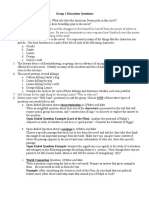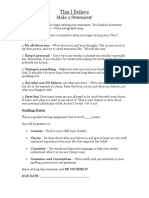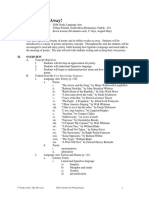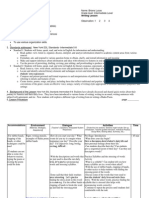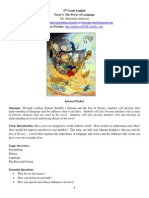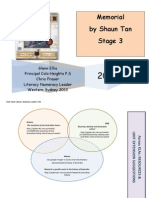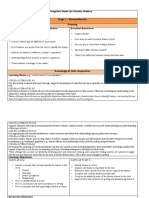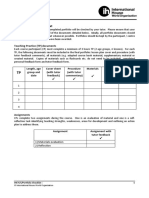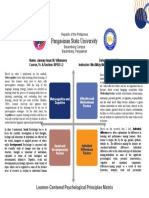The Teaching Sequence For Writing
The Teaching Sequence For Writing
Uploaded by
ggdhgaCopyright:
Available Formats
The Teaching Sequence For Writing
The Teaching Sequence For Writing
Uploaded by
ggdhgaOriginal Description:
Original Title
Copyright
Available Formats
Share this document
Did you find this document useful?
Is this content inappropriate?
Copyright:
Available Formats
The Teaching Sequence For Writing
The Teaching Sequence For Writing
Uploaded by
ggdhgaCopyright:
Available Formats
The Teaching Sequence for Writing
Teaching sequence Teachers: Pupils:
Read Real audience and purpose with a clear Establish clear purpose and audience. Enjoy reading a range of quality texts.
outcome. Choose quality challenging texts. Ask questions.
Model reading strategies, i.e. searchlights, Link to own experience.
Broad, rich and engaging reading
inference and deduction, writer’s use of language. Visualise.
curriculum. (Assessment focuses). Evaluate.
Planned drama, Make links between shared, guided and Identify audience and purpose.
speaking and
Empowering boys to become successful writers
independent work. Talk about how they are thinking and
listening Start to unpick the writer’s craft. learning.
opportunities. Begin to gather ideas for writing Role play, improvise.
Dynamic and supportive writing environment
Analyse Define features and characteristics of Are secure in Identify key features of text type/genre and
text/genre. knowledge and agree success criteria.
understanding of Practise using different features e.g. paired
Agree and understand the success
structure and language work constructing and varying sentences
criteria. features of text type. through speaking and listening activities.
Assessment for Learning
Prioritise which features
of text children need to
learn – sentence, text, word.
Provide interactive, investigate activities to meet
learning intentions e.g. construct, classify.
Provide stimulus for gathering ideas e.g. visual Talk about ideas and begin to map them out
Talk
Plan Use the success criteria.
Planned drama, speaking and literacy, integrated technologies, drama activities. on a plan e.g. writing skeleton, or story map.
Refer to checklist of success criteria.
listening opportunities.
Write Demonstration, teacher scribing and Are secure in understanding and use of three Are fully aware of the purpose and audience
supported composition. shared writing techniques. and write accordingly.
Model the use of success criteria developed from Develop a piece of writing over a number of
Self and peer assessment.
analysis to inform and evaluate writing. sessions.
Use knowledge of reading to help Integrate word/sentence level with text level to Refer to success criteria,
compose and make informed choices in exemplify their application. review their writing and
writing. Provide stimuli and resources to support and edit in response.
Structured, visual and dynamic Literacy enhance the writing process. Respond to feedback.
environment. Provide an element of choice.
Review Clear feedback linked to success Are effective in linking feedback to the success Can reflect on their successes and areas for
criteria. criteria. development. Can identify factors
Are confident in identifying areas of success and contributing to success and those causing
Understand next steps in developing
those for development that will impact on raising barriers in their work. Are clear in their next
writing. the standard of writing, they can explain and set steps in learning and engaged in addressing
Reflect on outcome against audience clear ‘next steps’. them.
and purpose. Provide further opportunities to write in that Are enthused by the challenge of using their
particular genre setting up the audience and knowledge to produce written work for a
purpose. particular audience and purpose.
You might also like
- Sixth Grade Country ReportDocument13 pagesSixth Grade Country Reportpascarf4429No ratings yet
- Report - International Film ClubDocument2 pagesReport - International Film Clubggdhga100% (2)
- Lesson Mysteries of Harris BurdickDocument4 pagesLesson Mysteries of Harris Burdickapi-260469323No ratings yet
- Year 4 - Information Report Compare and ContrastDocument3 pagesYear 4 - Information Report Compare and Contrastapi-315787363100% (1)
- MODULE 5 EvaluateDocument4 pagesMODULE 5 Evaluatecat l.100% (1)
- 526 Lesson Plan 4-Making ButterDocument3 pages526 Lesson Plan 4-Making Butterapi-282139286No ratings yet
- English G6 U4 L2 Treasure in The Attic HW 1Document6 pagesEnglish G6 U4 L2 Treasure in The Attic HW 1sa sa100% (1)
- The Response Process HandbookDocument37 pagesThe Response Process HandbookbusonNo ratings yet
- WritingenhancersDocument3 pagesWritingenhancersapi-260336583100% (1)
- Clinical LeadershipDocument31 pagesClinical LeadershipDedy Hartantyo100% (2)
- Ward RoundDocument19 pagesWard RoundrswonolNo ratings yet
- Of Mice and Men Socratic Seminar QuestionsDocument4 pagesOf Mice and Men Socratic Seminar Questionsapi-354352732100% (2)
- Literacy PlannerDocument11 pagesLiteracy PlannerDiana BergeonNo ratings yet
- Horror Unit Plan: 10 Grade Honors EnglishDocument17 pagesHorror Unit Plan: 10 Grade Honors Englishapi-294957224No ratings yet
- Assignment t3 StudentDocument11 pagesAssignment t3 Studentapi-237229446No ratings yet
- Literature Circle Snapshot FullDocument4 pagesLiterature Circle Snapshot FullByron Johnson Senior100% (1)
- This I Believe AssignmentDocument1 pageThis I Believe AssignmenttabithapangNo ratings yet
- Poetry UnitDocument44 pagesPoetry Unitapi-352484036No ratings yet
- TheMarrowThievesCreativeWritingProjectWriteYourOwnComingToStoryELA 1Document5 pagesTheMarrowThievesCreativeWritingProjectWriteYourOwnComingToStoryELA 1Victor RodriguezNo ratings yet
- WritinglessonDocument5 pagesWritinglessonapi-253646290No ratings yet
- Unit 7 Digital Notebook - Literary NonfictionDocument37 pagesUnit 7 Digital Notebook - Literary NonfictionKrispy KrunchyNo ratings yet
- Boyle Lit ChildrensLiterature BDocument6 pagesBoyle Lit ChildrensLiterature BeboyleNo ratings yet
- Literacy Unit Plan CorrectionsDocument12 pagesLiteracy Unit Plan Correctionsapi-311313472No ratings yet
- Daisy Kutter Graphic Novel Study UnitDocument14 pagesDaisy Kutter Graphic Novel Study Unitapi-219796746100% (1)
- Middle School Language Arts Lesson Plan Migrant StudentsDocument17 pagesMiddle School Language Arts Lesson Plan Migrant StudentsSue SlickNo ratings yet
- CSU Expository Reading and WritingDocument30 pagesCSU Expository Reading and WritingMary Lourdes SilvaNo ratings yet
- 6th Grade Assignment Term 3Document11 pages6th Grade Assignment Term 3api-237229446No ratings yet
- Reading ResponseDocument1 pageReading Responseapi-238297349No ratings yet
- Intro To Essay IngenieriasDocument18 pagesIntro To Essay IngenieriasDavid Gerardo Barboza JantesNo ratings yet
- Socratic Seminar: Practical Method For Applying The Strategy in The ClassroomDocument10 pagesSocratic Seminar: Practical Method For Applying The Strategy in The ClassroomChristy Bailey McManusNo ratings yet
- 6th Grade Reading Interest SurveyDocument6 pages6th Grade Reading Interest Surveyapi-385553468No ratings yet
- Interactive Lecture Slide Set NotesDocument20 pagesInteractive Lecture Slide Set Notesapi-449532015No ratings yet
- ENG125 - Critical Literary Theories PDFDocument7 pagesENG125 - Critical Literary Theories PDFfahadkhan100% (1)
- Collections Ny Scope and SequenceDocument62 pagesCollections Ny Scope and Sequenceapi-320980022No ratings yet
- Fiction Book Report DodecahedronDocument2 pagesFiction Book Report Dodecahedronapi-300553576No ratings yet
- Personal Narrative Assignment Outline and RubricDocument5 pagesPersonal Narrative Assignment Outline and Rubricapi-2740193110% (1)
- 5 Elements of A Short StoryDocument20 pages5 Elements of A Short StoryCris S. DisongloNo ratings yet
- Best Books Years 3Document3 pagesBest Books Years 3Magelican0% (1)
- Novel Project 2021-2022Document16 pagesNovel Project 2021-2022The2WhoCouldNo ratings yet
- WONDER Pre ReadingDocument3 pagesWONDER Pre ReadingUdad ManchegoNo ratings yet
- Reading HomeworkDocument2 pagesReading Homeworkapi-205822143No ratings yet
- MemorialDocument18 pagesMemorialS TANCRED100% (2)
- True Diary Discussion GuideDocument1 pageTrue Diary Discussion Guideapi-194333853No ratings yet
- West Hall High School Course Syllabus - American LitDocument2 pagesWest Hall High School Course Syllabus - American Litapi-272471185100% (2)
- Close ReadingDocument16 pagesClose Readingapi-223530755No ratings yet
- Novel Study Project Matrix - DivergentDocument1 pageNovel Study Project Matrix - Divergentapi-270398232No ratings yet
- Writing Success Criteria Exposition TextDocument1 pageWriting Success Criteria Exposition Textapi-262926913No ratings yet
- Updated Literature Circle Roles 2015Document13 pagesUpdated Literature Circle Roles 2015api-270337113No ratings yet
- Novel Study Unit PlanDocument18 pagesNovel Study Unit PlanLisa Battistone100% (2)
- Socratic Seminar MaterialsDocument45 pagesSocratic Seminar Materialsapi-373671607No ratings yet
- Elements of Non FictionDocument48 pagesElements of Non FictionSvienbjorg Garcia100% (1)
- Glencoe Lit Toc Course2Document6 pagesGlencoe Lit Toc Course2Jonathan SweetNo ratings yet
- How To Begin A Close ReadingDocument8 pagesHow To Begin A Close ReadingMichael Brian TorresNo ratings yet
- Independent Reading Project and Book TalkDocument1 pageIndependent Reading Project and Book Talkswasielewski0412No ratings yet
- Exemplar Ela UnitDocument69 pagesExemplar Ela Unitapi-287925081No ratings yet
- ELA - 8th Grade - Curriculum Map Essential Questions Chart PDFDocument2 pagesELA - 8th Grade - Curriculum Map Essential Questions Chart PDFamiana741No ratings yet
- Ocean Poems - Lesson PlanDocument0 pagesOcean Poems - Lesson PlanAugustaLeighNo ratings yet
- Back To School: Getting-To-Know-YouDocument8 pagesBack To School: Getting-To-Know-YouFlorinCristudorNo ratings yet
- Anthropology Writing Guide - HarvardDocument52 pagesAnthropology Writing Guide - HarvardVerónica Venturo GNo ratings yet
- Casey Middle School Suggested Summer Reading List 2019 5 GRADE: Authors of Wonderful Fiction Books For Summer ReadingDocument4 pagesCasey Middle School Suggested Summer Reading List 2019 5 GRADE: Authors of Wonderful Fiction Books For Summer ReadingLindsayNo ratings yet
- 7th ELA Module 4aDocument9 pages7th ELA Module 4aVirgilio Rosario BiagtanNo ratings yet
- Harris Burdick LessonDocument2 pagesHarris Burdick Lessonapi-266478183No ratings yet
- Unfamiliar Texts ExercisesDocument15 pagesUnfamiliar Texts ExercisesrobbNo ratings yet
- Opinion Planner OverviewDocument14 pagesOpinion Planner Overviewapi-525241634No ratings yet
- Essay - Unit 15.3Document1 pageEssay - Unit 15.3ggdhgaNo ratings yet
- Essay - Unit 13.3Document1 pageEssay - Unit 13.3ggdhgaNo ratings yet
- Letter - Environmental IssueDocument4 pagesLetter - Environmental IssueggdhgaNo ratings yet
- 1486017797.4616the Writing Teaching SequenceDocument3 pages1486017797.4616the Writing Teaching SequenceggdhgaNo ratings yet
- Carranza TOP NOTCH 1 Unit 2 P. 22Document2 pagesCarranza TOP NOTCH 1 Unit 2 P. 22ggdhgaNo ratings yet
- ECPE Prompt ArtistGallery TTDocument2 pagesECPE Prompt ArtistGallery TTggdhgaNo ratings yet
- Annotated Bib Final-2Document5 pagesAnnotated Bib Final-2api-317196887No ratings yet
- Barriers To Communication and Causes of Communication FailureDocument9 pagesBarriers To Communication and Causes of Communication Failuresatishluchmun100% (1)
- Kandel Et Al. 2014 The Molecular and Systems Biology of MemoryDocument24 pagesKandel Et Al. 2014 The Molecular and Systems Biology of MemoryJava UDNo ratings yet
- Đề Kiểm Tra Cuối Học Kì 1 Tiếng Anh 12 Global Success Theo Form 2025 Có Lời Giải - Đề 9-1734097918Document30 pagesĐề Kiểm Tra Cuối Học Kì 1 Tiếng Anh 12 Global Success Theo Form 2025 Có Lời Giải - Đề 9-1734097918BichTram Nguyen100% (1)
- DR JekyllDocument21 pagesDR JekyllJarir JamalNo ratings yet
- Commodity Music Analysed: Quasi Una FantasiaDocument9 pagesCommodity Music Analysed: Quasi Una FantasiaJeremy DavisNo ratings yet
- W Points: Psychosocial Factors in The Suicide of Yukio MishimaDocument9 pagesW Points: Psychosocial Factors in The Suicide of Yukio Mishimacata_banusNo ratings yet
- de-thi-hoc-ki-1-tieng-anh-8-english-discovery-de-so-3-1702272611 (1)Document3 pagesde-thi-hoc-ki-1-tieng-anh-8-english-discovery-de-so-3-1702272611 (1)Tue NguyenNo ratings yet
- Course Outline - Principles of ManagementDocument3 pagesCourse Outline - Principles of ManagementFrederick Gyekete Afari100% (2)
- 3 Year RPRTDocument61 pages3 Year RPRTMíchael The riderNo ratings yet
- IHCYLT Final Portfolio Checklist For CPs 2012Document3 pagesIHCYLT Final Portfolio Checklist For CPs 2012Ana PadillaNo ratings yet
- Tip Sheet 4 - The Clock Drawing Test (CDT) : Things To Be Aware of ScoringDocument2 pagesTip Sheet 4 - The Clock Drawing Test (CDT) : Things To Be Aware of ScoringPandu Bagus AllamNo ratings yet
- EGW Temporal LobeDocument9 pagesEGW Temporal LobeSem JeanNo ratings yet
- Med 1 EllaDocument3 pagesMed 1 EllaAshley GagtanNo ratings yet
- Y2 Lesson Plan Week 9Document10 pagesY2 Lesson Plan Week 9MOHD ZAKRI BIN RAMLI MoeNo ratings yet
- The Chemistry of Missing SomeoneDocument3 pagesThe Chemistry of Missing SomeoneBugeac Alexandru100% (2)
- 2019 01 02 NativeNews PDFDocument5 pages2019 01 02 NativeNews PDFAnonymous wfTFo4rZNo ratings yet
- Mental Ability Lecture - Order Position Blood Problem SolvingDocument19 pagesMental Ability Lecture - Order Position Blood Problem SolvingSujon MohammadNo ratings yet
- Job ApplicationDocument6 pagesJob ApplicationavneetkulwinderNo ratings yet
- Aes Tpack-Samr Staff SlidesDocument14 pagesAes Tpack-Samr Staff Slidesapi-306940216No ratings yet
- Activity 1-Villanueva, January Isaac M.-BPED I-2Document1 pageActivity 1-Villanueva, January Isaac M.-BPED I-2therealisaac.No ratings yet
- Audience AnalysisDocument4 pagesAudience Analysiszabir akhterNo ratings yet
- To Kill A Mockingbird - : Herriman High School - English 10 Honors 2019 - 2020Document10 pagesTo Kill A Mockingbird - : Herriman High School - English 10 Honors 2019 - 2020Cody LarndonNo ratings yet
- Asha Learning-Styles-Training-and-DevelopmentDocument8 pagesAsha Learning-Styles-Training-and-DevelopmentRaja Manish Tiwari OfficialNo ratings yet
- Brief Cognitive Behavioral Intervention For Children and Adolescents With Persistent Post Concussive Symptoms A Pilot StudyDocument18 pagesBrief Cognitive Behavioral Intervention For Children and Adolescents With Persistent Post Concussive Symptoms A Pilot StudyAdriana LeitaoNo ratings yet











